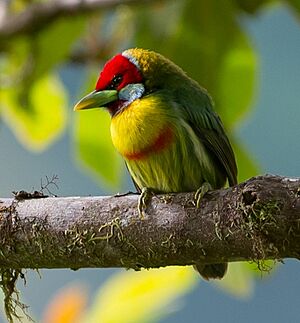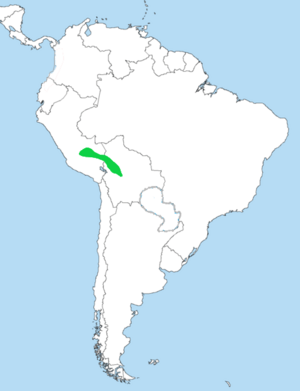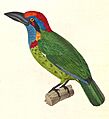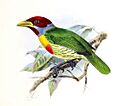Versicolored barbet facts for kids
Quick facts for kids Versicolored barbet |
|
|---|---|
 |
|
| Male "blue-moustached" form | |
| Conservation status | |
|
Not evaluated (IUCN 3.1)
|
|
| Scientific classification | |
| Genus: |
Eubucco
|
| Species: |
versicolor
|
 |
|
The versicolored barbet is a super colorful bird found in Bolivia and Peru. It belongs to a bird family called New World barbets. These birds are known for their bright feathers and strong beaks.
Contents
Bird Families and Types
Scientists group living things into families and types. The versicolored barbet was first described by a scientist named Statius Müller in 1776. He named it Bucco versicolor.
Today, scientists are still discussing how to group these birds. Some groups, like the American Ornithological Society, think there is one main species with three slightly different types, called subspecies. Other groups, like BirdLife International, think these three types are actually separate species.
The three main types (subspecies) are:
- E. v. steerii (the "blue-cowled" type)
- E. v. glaucogularis (the "blue-chinned" type)
- E. v. versicolor (the "blue-moustached" type)
What the Versicolored Barbet Looks Like
The versicolored barbet is very colorful, just like its name suggests! All barbets have a strong, sturdy beak. The different types of versicolored barbets look a bit different, especially in their feather patterns.
All the male barbets have a red face and the top of their head is also red. Their upper bodies are green or blue-green. The lower part of their chest is red, and their bellies are yellowish with green stripes. The amount of red on their chest can change.
Female barbets also have green or blue-green upper bodies. Their bellies are yellowish with green stripes, similar to the males. All these birds are about 16 cm (6.3 in) long. Their weight can be different depending on the type.
The "Blue-Moustached" Type
This type weighs about 28 to 39 g (0.99 to 1.38 oz).
- The male has a red throat with a thin blue band below it.
- It has a blue patch on its cheek, which looks like a "moustache."
- A blue band separates its red head from its green back.
- Its upper chest is yellow.
- The female has a greenish cap on its head.
- It has blue cheek patches with a yellow edge.
- The female's throat is blue with a thin red band below it.
The "Blue-Cowled" Type
This type weighs about 31 to 37 g (1.1 to 1.3 oz).
- The back of the male's head and its neck (like a "cowl") are blue.
- It has a red chin and yellow cheek patches and throat.
- The female's head and neck are yellow.
- Its face, throat, and upper chest are blue.
- A thin red crescent shape divides its throat and chest.
The "Blue-Chinned" Type
This type weighs about 26 to 41 g (0.92 to 1.45 oz).
- The male has a thin blue band behind its head, similar to the "blue-moustached" type.
- It has a yellow cheek patch.
- Between its beak and its yellow upper chest, it has bands of red, blue, and orange.
- The female has a yellow head and neck.
- Its face and throat are blue with a red band below the throat.
Where Versicolored Barbets Live
Each type of versicolored barbet lives in slightly different areas:
- The "blue-moustached" type is found in Peru (in the Cuzco and Puno Regions) and goes east into north-central Bolivia.
- The "blue-cowled" type lives only in Peru, from west-central Amazonas south to northern Huánuco.
- The "blue-chinned" type also lives only in Peru, along the eastern side of the Andes mountains. This area stretches from eastern Huánuco to northern Cuzco.
All types of versicolored barbets live in damp forests, especially those with many epiphytes (plants that grow on other plants) and mosses. They also like older secondary forests (forests that have grown back after being cut down). They usually live at high places, from 1,000 to 2,000 m (3,300 to 6,600 ft) above sea level. Some can even be found as high as 2,225 m (7,300 ft). The "blue-moustached" type can also live in dry forests in Bolivia.
Behavior and Habits
Feeding Habits
Scientists have mostly studied the "blue-moustached" type's diet and how it finds food. The other types are thought to eat and hunt in similar ways. About 80% of its diet is fruits and seeds. The rest of its diet is mostly arthropods (like insects and spiders).
This barbet looks for food alone, in pairs, or sometimes with other bird species. It usually searches for food between 10 and 25 m (33 and 82 ft) above the ground. It finds arthropods by poking and tearing apart bunches of dead leaves.
Reproduction
Scientists have not studied the breeding habits of each barbet type separately. It seems that these birds lay eggs between July and December. One nest of the "blue-moustached" type was found in a tree hole. It had three eggs inside.
Vocalization (Songs and Calls)
The different types of versicolored barbets all sound similar. Their song is described as "a fast, low-pitched trill" [1].
Conservation Status
The IUCN (International Union for Conservation of Nature) checks how common or rare animals are. They have looked at each type of versicolored barbet separately.
- The "blue-moustached" and "blue-cowled" types are considered of Least Concern. This means they are not currently at risk of disappearing. (The "blue-cowled" type was once rated Near Threatened until 2020, but its situation improved.)
- The "blue-chinned" type is considered Near Threatened. This means its population might be getting smaller quite quickly, and there might not be many of them left.
Images for kids




